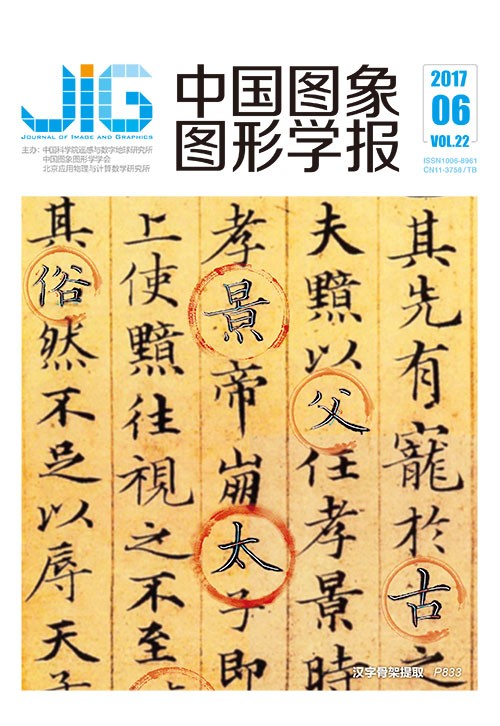
融合方向特性与不确定性的脉冲噪声滤波
摘 要
目的 随机噪声的噪声阈值具有不确定性和敏感性,寻找一个鲁棒的阀值是非常困难的,这严重影响了噪声的提取效率。为提高噪声判断的准确性,提出一种基于方向特性与中智不确定性融合的双端脉冲检测算法;另外,为加强优良像素在滤波过程中的权重,构建了一种基于像素中智不确定性和ROAD(rank-ordered absolute differences)统计量的新型双边滤波函数。方法 在噪声检测阶段,首先根据ROLD(rank-ordered logarithmic difference)与噪声阈值T的关系,将污染图像的像素分为超限域像素(ROLD ≥ T)、邻限域像素(0.8T ≤ ROLD<T)和安全域像素(ROLD<0.8T),并利用开关机制完成一次噪声检测。在此基础上,为提高超限域和邻限域像素噪声检测的准确性,采用不同策略对其进行二次噪声排查:对超限域像素,利用新型25像素和9像素4方向模板计算像素基于排序的方向对数差统计量,由该统计量与T的大小关系决定当前像素的噪声真伪;对邻限域像素,则结合当前像素中智不确定性在滤波窗内的排序信息来进一步确定其噪声特性。在滤波阶段,利用像素中智不确定性和ROAD统计量构建新型双边滤波函数,以加强低不确定性和高相似性像素在图像恢复中的权重。结果 针对实验图像,双端脉冲检测算法的边缘像素提取率最高可达67%、邻限域像素的噪声剔除率最高可达91%,大大降低了阈值对噪声提取的敏感性,从而提高了噪声判断的正确率。在10%~80%噪声范围内,本文算法的主观性能和峰值信噪比都优于其他7种算法。结论 本文基于双端检测和新型双边滤波函数的新算法,在噪声检测和去噪过程中均充分考虑了图像本身的方向性和噪声的不确定性,因此提高了噪声提取及像素滤波权重的准确性,从而有效地保护了图像的边缘和细节信息。
关键词
Novel impulse noise removal algorithm based on the fusion of directional characteristic and indeterminacy information
Qi Xianying1,2, Liu Boqiang1, Xu Jianwei3, Song Li2(1.School of Control Science and Engineering, Shandong University, Jinan 250061, China;2.Department of Radiology, Taishan Medical University, Taian 271000, China;3.Taian Cancer Prevention and Treatment Hospital, Taian 271000, China) Abstract
Objective The inherent uncertainty and randomness of a random-valued impulse result in the indeterminacy and sensibility of the noise threshold. Obtaining a robust noise threshold during noise reduction is therefore difficult because of these poor features. Moreover, the noise extraction efficiencies of algorithms used for random-valued impulse reduction are seriously affected. To improve the accuracy of noise detection, this study proposes an efficient double-side impulse noise detection algorithm based on the directional characteristic and neutrosophic indeterminacy information. Given that an accurate and effective weight function is important to the performance of a filter, a new bilateral filter based on neutrosophic indeterminacy and rank-ordered absolute difference (ROAD) statistic is constructed to strengthen the weights of pixels that are similar to the current pixel and restrain the influence of pixels with high indeterminacy.Method For noise detection, an adaptive function of noise threshold T is designed according to the relation between the performance of the peak signal-to-noise ratio (PSNR) and threshold T. The value of T can be automatically adjusted in this function according to the density of noise. After the values of the rank-ordered logarithmic difference (ROLD) and neutrosophic indeterminacy of each pixel are calculated, the pixels in the polluted image are divided into three types according to the relationship between the ROLD value and the threshold. The first type comprises exceeding-threshold pixels whose ROLD values are greater than or equal to threshold T. The second category comprises adjacent-threshold pixels whose ROLD values are equal to or greater than 0.8 T but less than T. The last category comprises security pixels that have ROLD values less than 0.8 T. All pixels belonging to these three types are roughly divided into noise and noise-free sets by using a switching strategy. Pixels belonging to the first type are temporarily classified as corrupted pixels because their ROLD values are greater than T.All pixels belonging to the second and third types are temporarily regarded as uncorrupted pixels because their ROLD values are less than T. To improve the accuracy of noise evaluation in the exceeding-and adjacent-threshold regions, different strategies are adopted to conduct a second noise examination. Pixels in the exceeding-threshold region are further detected by exploiting the directional ROLD statistics. Before the directional statistics are calculated, 45°, 90°, 135°and 180° directional templates are designed, and different templates are applied under different noise densities. Templates with 9 pixels are used in the low-noise environment, and templates with 25 pixels are used in the high-noise condition to limit the harmful impact of noise. The smallest among the four directional ROLD values is selected as a pixel's final directional ROLD. Whether a pixel is a real noise is decided by the relationship between directional ROLD and threshold T. When the selected directional statistic is less than the preset T,the present pixel is firmly regarded as false noise and deleted from the noise set. Pixels in the adjacent-threshold region are re-detected by applying the statistical information of rank-ordered neutrosophic indeterminacy. When the ranking order of a pixel's neutrosophic indeterminacy is in the first three places of the filtering window, the current pixel is reclassified as noise and removed from the noise-free set. During filtering, to enhance the weights of excellent pixels that possess low indeterminacy and high similarity, a new bilateral function is built based on the ROAD statistic and neutrosophic indeterminacy. The weight of a specific pixel is jointly determined by the value of ROAD and the degree of indeterminacy information. All pixels extracted as noises are restored by applying the new bilateral function, and an iterative filtering mechanism is used for denoising to achieve a satisfactory result.Result Experiments show that in the exceeding-threshold region, a number of edge pixels that have been incorrectly evaluated as noises in the first checking can be extracted, and the extraction ratio of these pixels is as high as 67%. In the adjacent-threshold region, about 91% of the pixels whose statistical values are less than but close to the noise threshold can be re-extracted from noise-free set. The proposed double-side impulse noise detection algorithm not only reduces the sensitivity of the impulse noise threshold but also improves the validity of noise judgment. Under noise ratios from 10% to 80%, the proposed algorithm is compared with seven other algorithms. The new method is the best among the algorithms in terms of PSNR, mean differences in PSNR and subjective quality.Conclusion The double-side impulse noise detection algorithm maximizes the use of the image directional characteristic and neutrosophic indeterminacy information during noise checking. It efficiently reduces the false rate in the exceeding-threshold region and the missed rate in the adjacent-threshold region. Therefore, many edge pixels are not damaged. The double-side detection algorithm significantly decreases the sensitivity of the noise threshold and enhances the correctness of noise detection. Furthermore, the new bilateral filter improves the accuracy of a pixel's weight by using two features to measure pixel similarity. In short, the proposed filter based on double-side impulse noise detection and a novel bilateral function fully considers uncertainty and directional information. The edges and details of the image are well protected and efficiently recovered.
Keywords
random impulse noise sensitivity of noise threshold double-side noise detection directional template neutrosophic indeterminacy new bilateral filter
|



 中国图象图形学报 │ 京ICP备05080539号-4 │ 本系统由
中国图象图形学报 │ 京ICP备05080539号-4 │ 本系统由